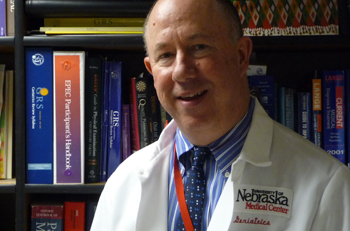On the eve of UNMC’s Anatomical Memorial Service, William Lyons, M.D., associate professor, internal medicine geriatrics, shares, in his own words, his recollections of the gross anatomy lab.
UNMC students organize the memorial service each year to pay tribute to the hundreds of people who donate their bodies to the Nebraska Anatomical Board to be used for health care education and research. About half the bodies donated to the board come to UNMC, where students use them to learn anatomy.
 |
William Lyons, M.D. |
Although many of the specific anatomic lessons have faded from my memory, I remember five things about the experience of dissecting our cadaver.
First, the human body is a miraculous machine, and its designer a peerless engineer.
Second, gross anatomy — like medicine itself — cannot possibly be absorbed in its entirety. Even the smartest first-year medical student learns humility in the face of the task.
Third, gross anatomy — again like medicine — is best done as part of a team. The loner college student entering medical school changes his ways when confronting this task.
Fourth, the human body, miraculous as it is, is not designed for eternal use. Clots plug key blood vessels, infections fill lungs, brains fail and our season is done.
Last, there are two experiences in every doctor’s life when he recognizes that he is no longer like other people, but has instead joined the society of physicians. The second is internship, when real patients first look to him for treatment. But the first is the gross anatomy lab, when, as a student, he meets a vulnerable, exposed stranger, takes scalpel in hand and does that which only doctors have privilege to do.